The Exceptionally Cold January of 2017 over the Balkan Peninsula: A Climatological and Synoptic Analysis
Abstract
:1. Introduction
2. Data and Methodology
2.1. Data
2.2. Methodology
3. Results
3.1. Climatology
3.2. Extreme Analysis
3.3. The Cold Spell of January 2017: A Synoptic Analysis
4. Discussion and Conclusions
Acknowledgments
Author Contributions
Conflicts of Interest
References
- Maheras, P. Climatologie de la mer Egée et de ces Marges Continentales. Etude de Climatologie Descriptive et de Climatologie Dynamique. Thèse d ‘Etat, Atelier de Reproduction de Thèses de Lille III, Université de Lille III, France, 1982. [Google Scholar]
- Tolika, K.; Maheras, P.; Pytharoulis, I.; Anagnostopoulou, C. The anomalous low and high temperatures of 2012 over Greece—An explanation from a meteorological and climatological perspective. Nat. Hazards Earth Syst. Sci. 2014, 14, 501–507. [Google Scholar] [CrossRef]
- Makrogiannis, T.J.; Giles, B.D.; Flocas, A.A. The problem of the extension of the Siberian Anticyclone towards southeast Europe, and its relation to atmospheric circulation anomalies over the northern hemisphere. Arch. Meteorol. Geophys. Bioclimatol. Ser. A 1981, 30, 185–196. [Google Scholar] [CrossRef]
- Reinhold, B.; Pierrehumbert, R. Dynamics of weather regimes: Quasi-stationary waves and blocking. Mon. Weather Rev. 1982, 110, 1105–1145. [Google Scholar] [CrossRef]
- Legras, B.; Ghil, M. Persistent anomalies, blocking and variations in atmospheric predictability. J. Atmos. Sci. 1985, 42, 433–471. [Google Scholar] [CrossRef]
- Sillmann, J.; Croci-Maspoli, M.; Kallache, M.; Katz, R.W. Extreme cold winter temperatures in Europe under the influence of North Atlantic atmospheric blocking. J. Clim. 2011, 24, 5899–5913. [Google Scholar] [CrossRef]
- Anstey, J.A.; Davini, P.; Gray, L.J.; Woollings, T.J.; Butchart, N.; Cagnazzo, C.; Yang, S. Multi-model analysis of Northern Hemisphere winter blocking: Model biases and the role of resolution. J. Geophys. Res. Atmos. 2013, 118, 3956–3971. [Google Scholar] [CrossRef]
- Whan, K.; Zwiers, F.; Sillmann, J. The influence of atmospheric blocking on extreme winter minimum temperatures in North America. J. Clim. 2016, 29, 4361–4381. [Google Scholar] [CrossRef]
- Wheeler, D.D.; Harvey, V.L.; Atkinson, D.E.; Collins, R.L.; Mills, M.J. A climatology of cold air outbreaks over North America: WACCM and ERA-40 comparison and analysis. J. Geophys. Res. Atmos. 2011, 116. [Google Scholar] [CrossRef]
- Fortune, M.; Kousky, V.E. Two severe freezes in Brazil: Precursors and synoptic evolution. Mon. Weather Rev. 1983, 111, 181–196. [Google Scholar] [CrossRef]
- Vera, C.S.; Vigliarolo, P.K. A diagnostic study of cold-air outbreaks over South America. Mon. Weather Rev. 2000, 128, 3–24. [Google Scholar] [CrossRef]
- Marengo, J.A.; Ambrizzi, T.; Kiladis, G.; Liebmann, B. Upper-air wave trains over the Pacific Ocean and wintertime cold surges in tropical-subtropical South America leading to Freezes in Southern and Southeastern Brazil. Theor. Appl. Climatol. 2002, 73, 223–242. [Google Scholar] [CrossRef]
- Kuhlemann, J.; Rohling, E.J.; Krumrei, I.; Kubik, P.; Ivy-Ochs, S.; Kucera, M. Regional synthesis of Mediterranean atmospheric circulation during the Last Glacial Maximum. Science 2008, 321, 1338–1340. [Google Scholar] [CrossRef] [PubMed]
- Hayes, A.; Kucera, M.; Kallel, N.; Sbaffi, L.; Rohling, E.J. Glacial Mediterranean sea surface temperatures based on planktonic foraminiferal assemblages. Quat. Sci. Rev. 2005, 24, 999–1016. [Google Scholar] [CrossRef]
- Hurrell, J. Decadal trends in the North Atlantic Oscillation: Regional temperatures and precipitation. Science 1995, 26, 676–679. [Google Scholar] [CrossRef] [PubMed]
- Brown, S.J.; Caesar, J.; Ferro, C.A.T. Global changes in extreme daily temperature since 1950. J. Geophys. Res. 2008, 113. [Google Scholar] [CrossRef]
- Castro-Dıez, Y.; Pozo-Vazquez, D.; Rodrigo, F.S.; Esteban-Parra, M.J. NAO and winter temperature variability in southern Europe. Geophys. Res. Lett. 2002, 29. [Google Scholar] [CrossRef]
- Cattiaux, J.; Vautard, R.; Cassou, C.; Yiou, P.; Masson-Delmotte, V.; Codron, F. Winter 2010 in Europe: A cold extreme in a warming climate. Geophys. Res. Lett. 2010, 37. [Google Scholar] [CrossRef]
- Unkasevic, M.; Tosic, I. Changes in extreme daily winter and summer temperatures in Belgrade. Theor. Appl. Climatol. 2009, 95, 27–38. [Google Scholar] [CrossRef]
- Klein Tank, A.M.G.; Wijngaard, J.B.; Konnen, G.P.; Böhm, R.; Demaree, G.; Gocheva, A.; Mileta, M.; Pashiardis, S.; Hejkrilik, L.; Kern-Hansen, C.; et al. Daily dataset of 20th-century surface air temperature and precipitation series for the European climate assessment. Int. J. Climatol. 2002, 22, 1441–1453. [Google Scholar] [CrossRef]
- Lagouvardos, K.; Kotroni, V.; Bezes, A.; Koletsis, I.; Kopania, T.; Lykoudis, S.; Mazarakis, N.; Papagiannaki, K.; Vougioukas, S. The automatic weather stations NOANN network of the National Observatory of Athens: Operation and database. Geosci. Data J. 2017, 4, 1–16. [Google Scholar] [CrossRef]
- Coles, S.; Bawa, J.; Trenner, L.; Dorazio, P. An Introduction to Statistical Modeling of Extreme Values; Springer: London, UK, 2001; Volume 208. [Google Scholar]
- Hosking, J.R.M. L-moments: Analysis and estimation of distributions using linear combinations of order statistics. J. R. Stat. Soc. Ser. B 1990, 52, 105–124. [Google Scholar]
- Lazoglou, G.; Anagnostopoulou, C.; Tolika, K.; Kolyva-Machera, F. A review of statistical methods to analyze the extreme precipitation and temperature events in the Mediterranean region. Proceedings 2017, 1, 681. [Google Scholar]
- Katz, R.W.; Grotjahn, R. Statistical methods for relating temperature extremes to large-scale meteorological patterns. US Clivar Var. 2014, 12, 4–7. [Google Scholar]
- Kioutsioukis, I.; Melas, D.; Zerefos, C. Statistical assessment of changes in climate extremes over Greece (1955–2002). Int. J. Climatol. 2010, 30, 1723–1737. [Google Scholar] [CrossRef]
- Goubanova, K.; Li, L. Extremes in temperature and precipitation around the Mediterranean basin in an ensemble of future climate scenario simulations. Glob. Planet. Chang. 2007, 57, 27–42. [Google Scholar] [CrossRef]
- Cueto, O.G.; Soto, N.S.; Núñez, M.Q.; Benítez, S.O.; Limón, N.V. Extreme temperature scenarios in Mexicali, Mexico under climate change conditions. Atmósfera 2013, 26, 509–520. [Google Scholar] [CrossRef]
- Luterbacher, J.; Dietrich, D.; Xoplaki, E.; Grosjean, M.; Wanner, H. European seasonal and annual temperature variability, trends, and extremes since 1500. Science 2004, 303, 1499–1503. [Google Scholar] [CrossRef] [PubMed]
- Yiou, P.; Nogaj, M. Extreme climatic events and weather regimes over the North Atlantic: When and where? Geophys. Res. Lett. 2004, 31. [Google Scholar] [CrossRef]
- Scaife, A.A.; Knight, J.R. Ensemble simulations of the cold European winter of 2005-2006. Q. J. R. Meteorol. Soc. 2008, 134, 1647–1659. [Google Scholar] [CrossRef]
- Peterson, T.C.; Stott, P.A.; Herring, S. Explaining extreme events of 2011 from a climate perspective. Bull. Am. Meteorol. Soc. 2012, 93, 1041–1067. [Google Scholar] [CrossRef]
- Guirguis, K.; Gershunov, A.; Schwartz, R.; Bennett, S. Recent warm and cold daily winter temperature extremes in the Northern Hemisphere. Geophys. Res. Lett. 2011, 38. [Google Scholar] [CrossRef]
- Hirschi, J.J.M.; Sinha, B. Negative NAO and cold Eurasian winters: How exceptional was the winter of 1962/1963? Weather 2007, 62, 43–48. [Google Scholar] [CrossRef]
- Jung, T.; Palmer, T.N.; Rodwell, M.J.; Serrar, S. Understanding the Anomalously Cold European Winter of 2005/06 Using Relaxation Experiments. Mon. Weather Rev. 2010, 138, 3157–3173. [Google Scholar] [CrossRef]
- Hatzaki, M.; Flocas, H.A.; Asimakopoulos, D.N.; Maheras, P. The eastern Mediterranean teleconnection pattern: Identification and definition. Int. J. Climatol. 2007, 27, 727–737. [Google Scholar] [CrossRef]
- Hatzaki, M.; Flocas, H.A.; Giannakopoulos, C.; Maheras, P. The impact of the eastern Mediterranean teleconnection pattern on the Mediterranean climate. J. Clim. 2009, 22, 977–992. [Google Scholar] [CrossRef]
- Godoy, A.A.; Possia, N.E.; Campetella, C.M.; García Skabar, Y. A cut-off low in southern South America: Dynamic and thermodynamic processes. Rev. Bras. Meteorol. 2011, 26, 503–514. [Google Scholar] [CrossRef]
- Nieto, R.; Gimeno, L.; de La Torre, L.; Ribera, P.; Gallego, D.; García-Herrera, R.; Lorente, J. Climatological features of cutoff low systems in the Northern Hemisphere. J. Clim. 2005, 18, 3085–3103. [Google Scholar]
- Nieto, R.; Sprenger, M.; Wernli, H.; Trigo, R.M.; Gimeno, L. Identification and Climatology of Cut-off Lows near the Tropopause. Ann. N. Y. Acad. Sci. 2008, 1146, 256–290. [Google Scholar] [CrossRef] [PubMed]
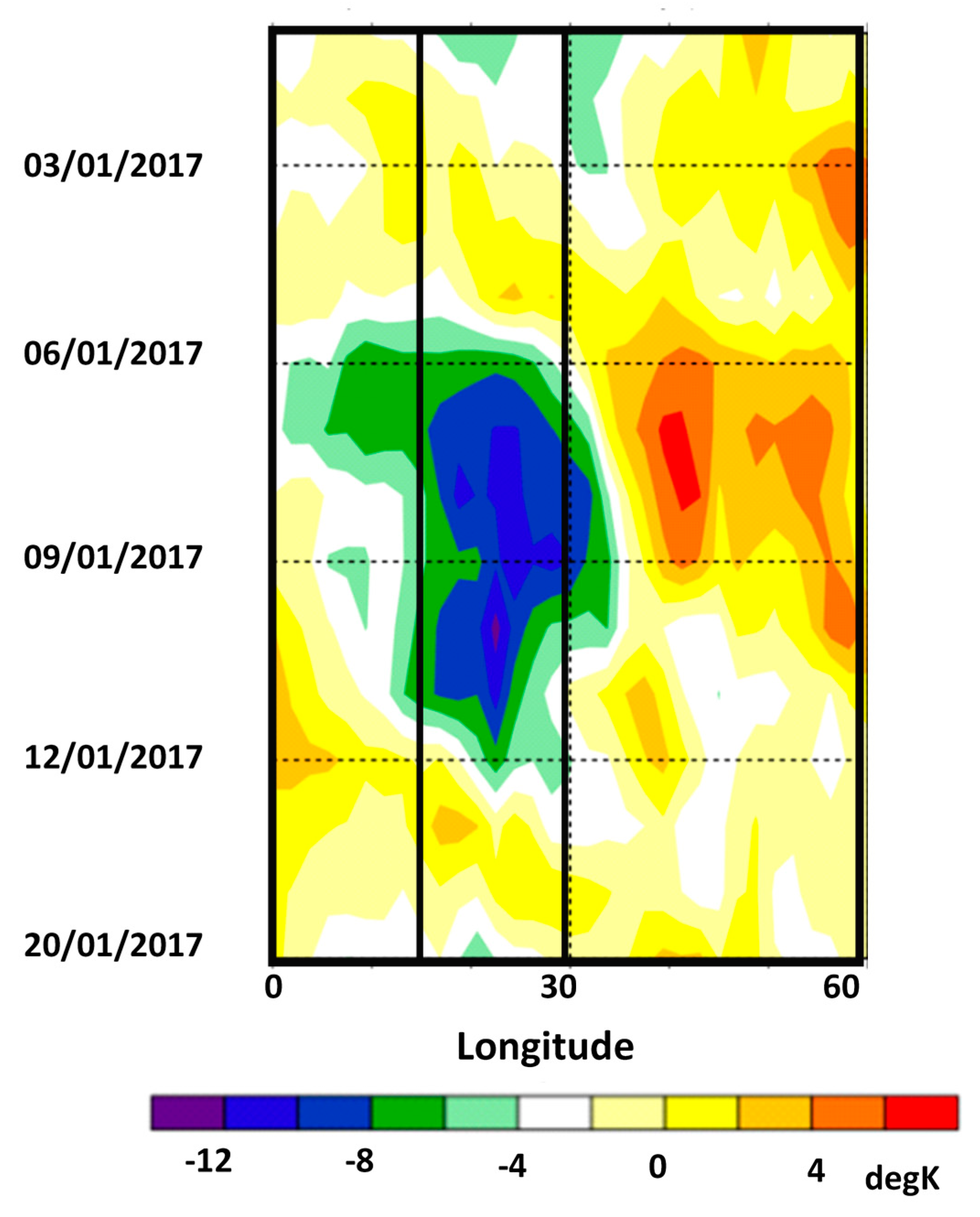
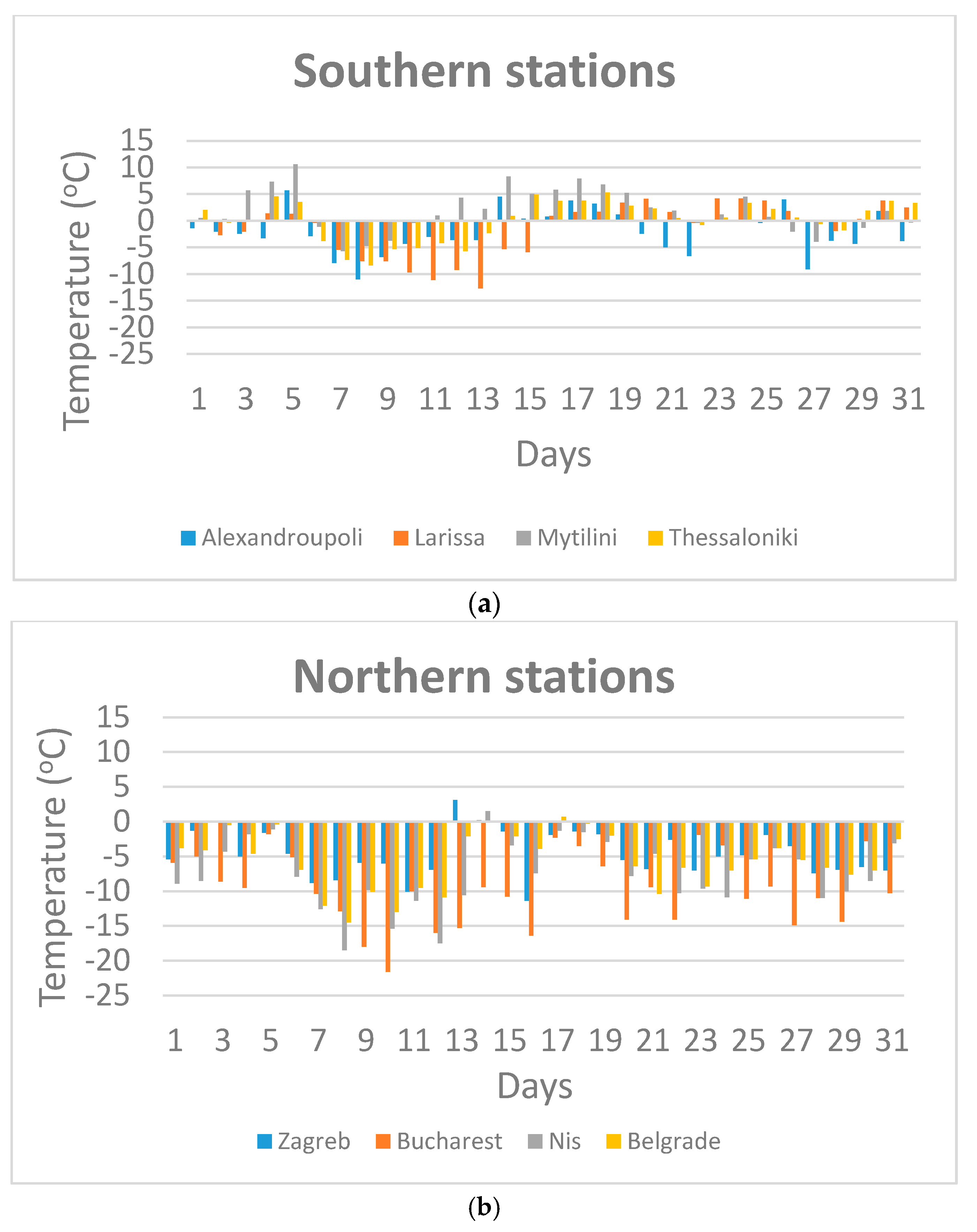
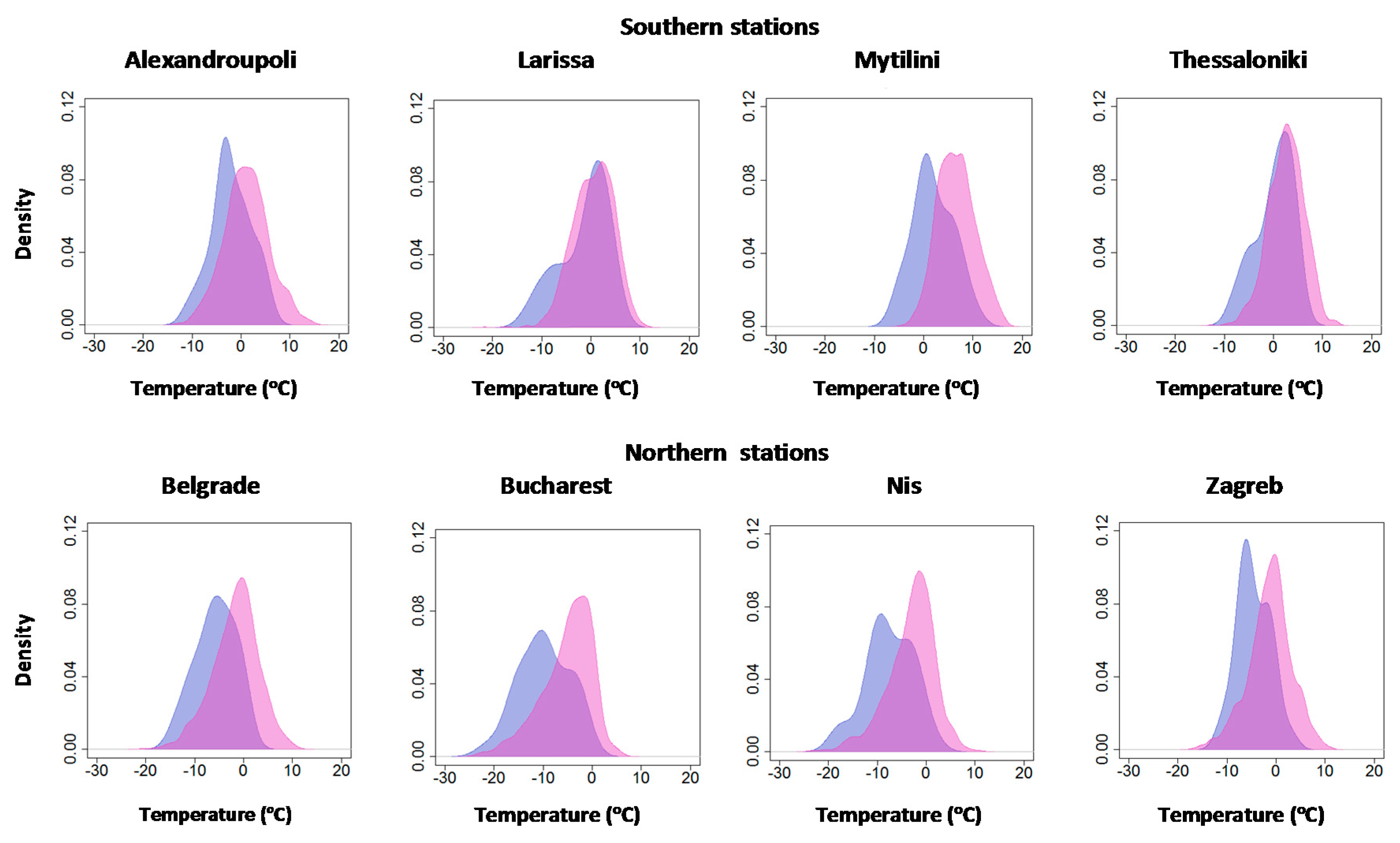
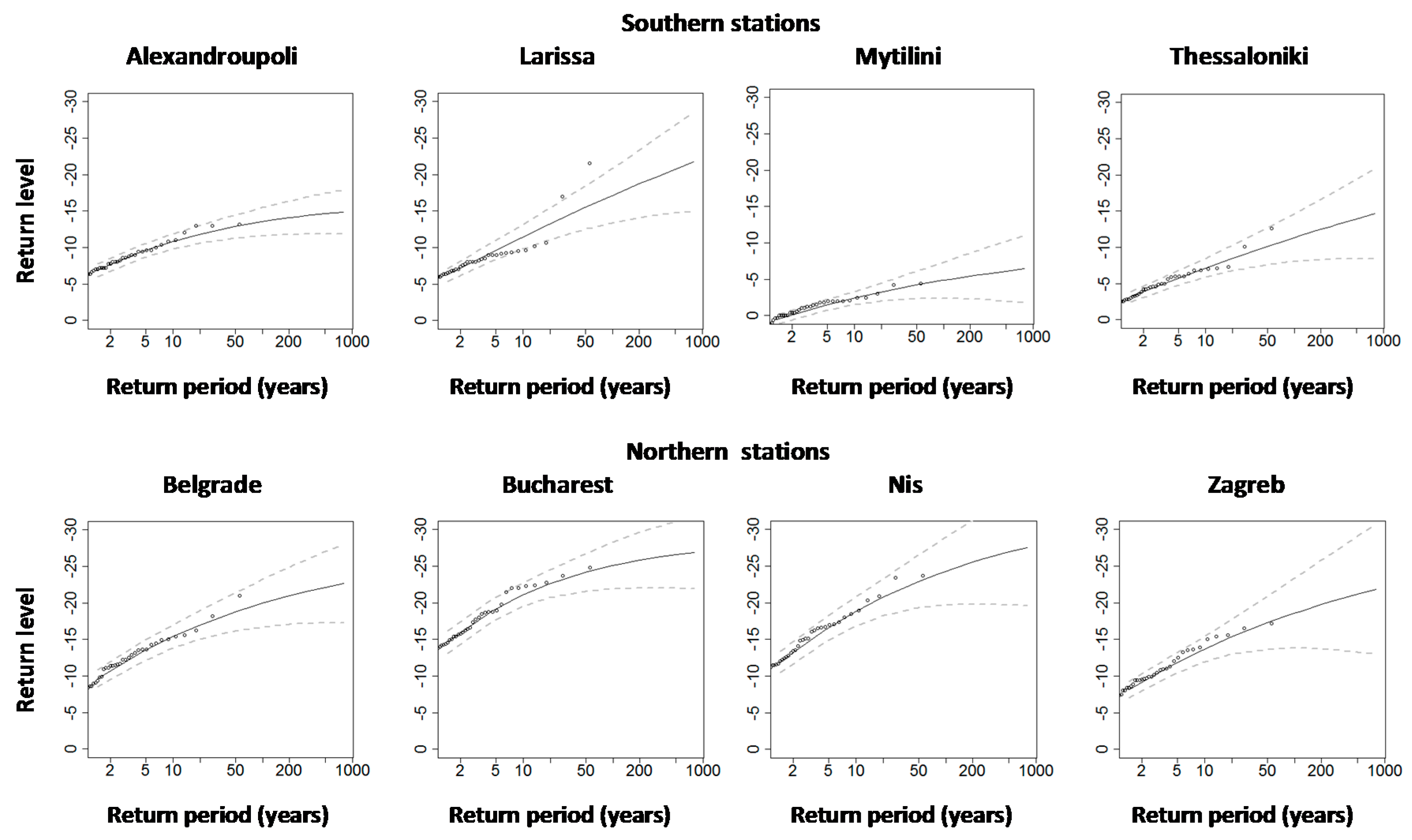

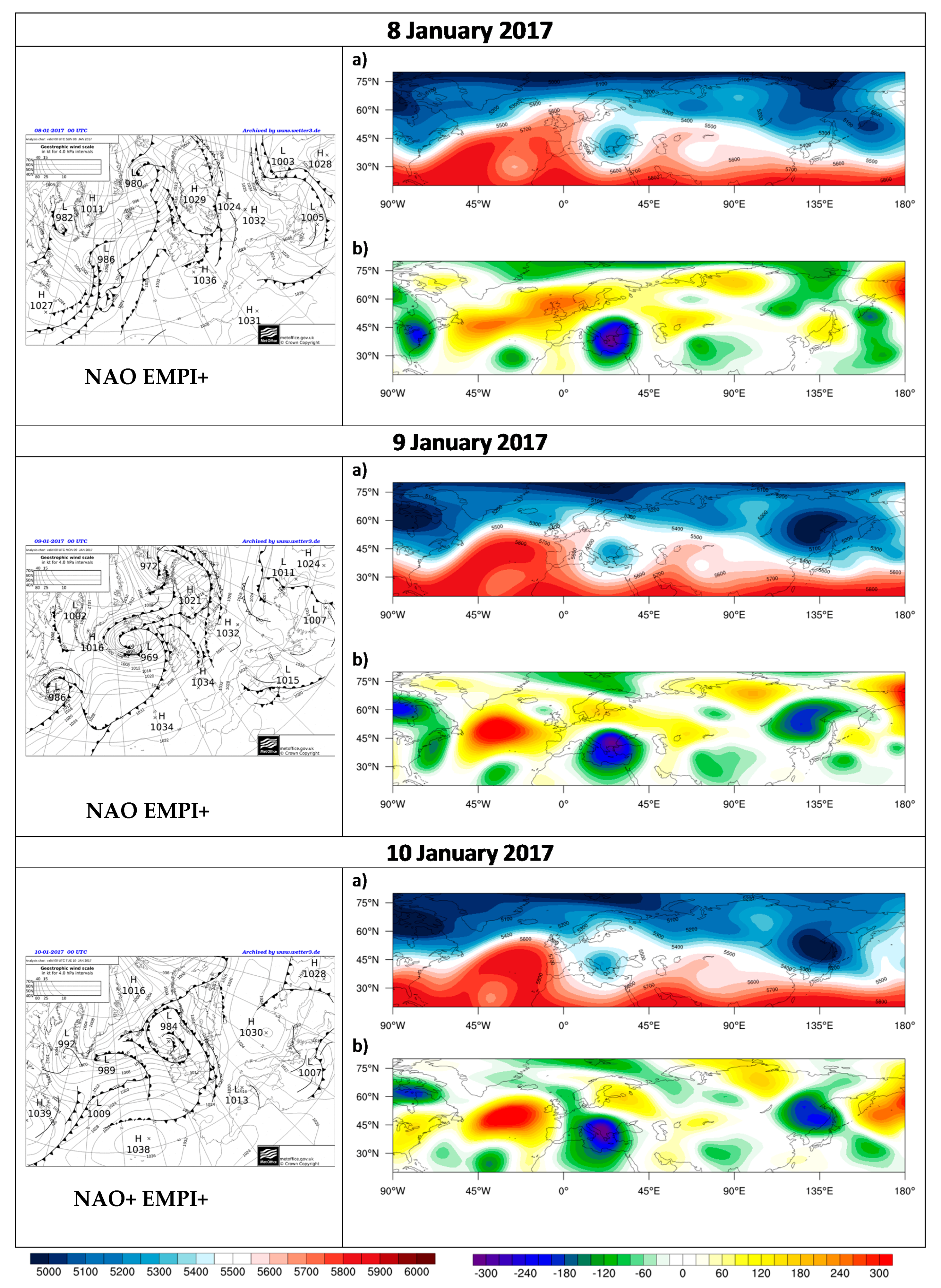
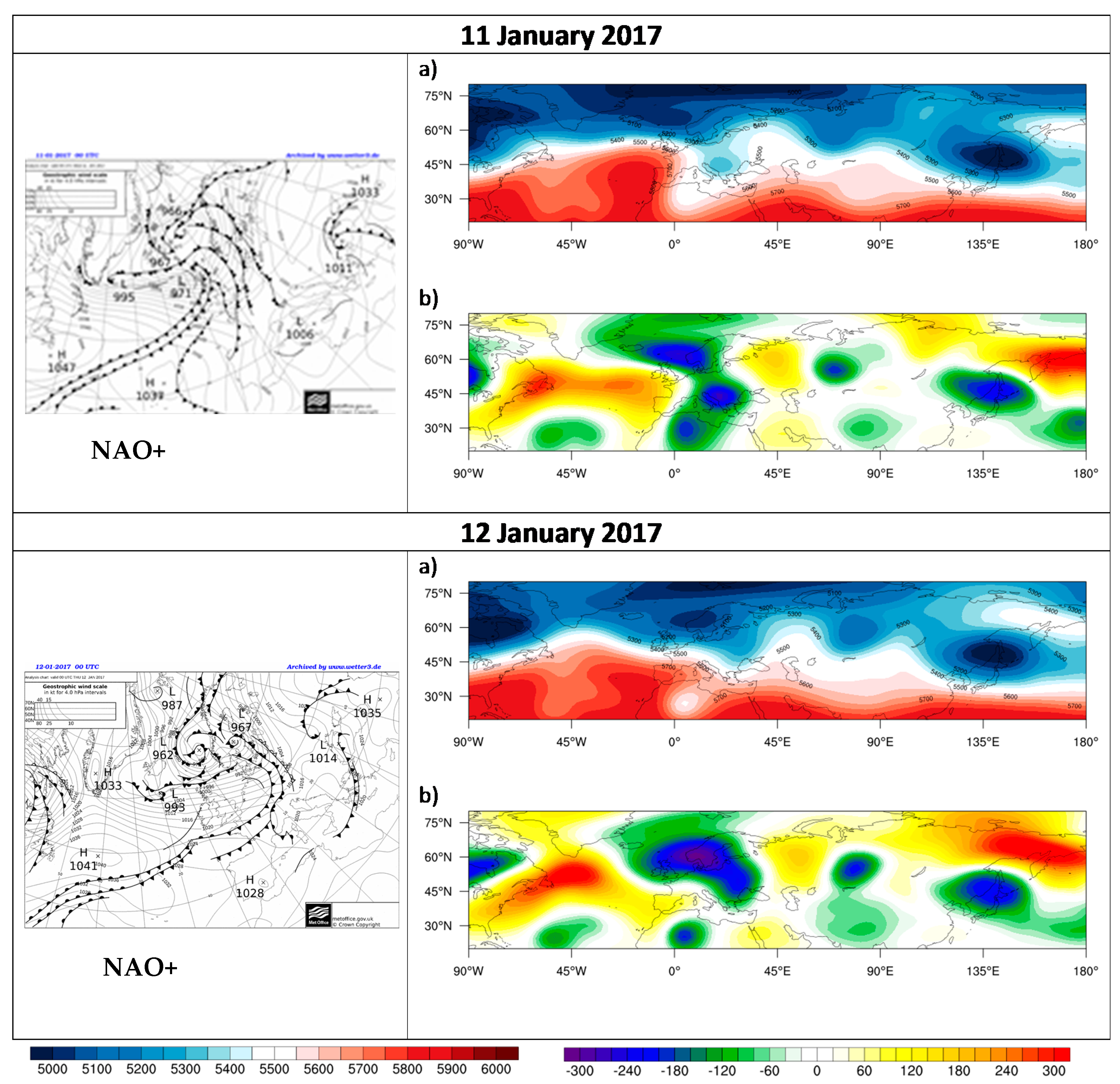
| Stations | Country | Longitude (°) | Latitude (°) | Altitude (m) |
|---|---|---|---|---|
| Alexandroupoli | Greece | 25.92 | 40.85 | 19 |
| Belgrade | Serbia | 20.5 | 44.8 | 132 |
| Bucharest | Romania | 27.1 | 44.5 | 90 |
| Larissa | Greece | 22.42 | 39.63 | 83 |
| Mytilini | Greece | 26.50 | 39.07 | 7 |
| Nis | Serbia | 21.9 | 44.3 | 201 |
| Thessaloniki | Greece | 22.95 | 40.62 | 36 |
| Zagreb | Croatia | 16.7 | 45.8 | 156 |
| Alex | Belg | Buch | Lari | Myti | Nis | Thes | Zag | ||
|---|---|---|---|---|---|---|---|---|---|
| 1958–2012 | MTN | 1.1 | −1.1 | −5.2 | 0.5 | 6.6 | −3.1 | 2.6 | −1.3 |
| ATN | −13.2 | −21.0 | −24.8 | −21.6 | −4.4 | −23.7 | −12.6 | −17.2 | |
| 95TN | −6.6 | −10.4 | −15.3 | −6.4 | 0.6 | −12.0 | −3.6 | −9.3 | |
| MFD | 12 | 19 | 27 | 13 | 1 | 22 | 7 | 19 | |
| 95FD | 22 | 28 | 31 | 24 | 4 | 29 | 16 | 28 | |
| 2017 | Mean Tmin (MTN) | −2.0 (−3.1) | −5.7 (−4.6) | −9.9 (−4.7) | −1.5 (−2.0) | 1.9 (−4.7) | −7.5 (−4.5) | 0.1 (−2.5) | −4.7 (−3.5) |
| Absolute daily Tmin (ATN) | −11.0 (2.2) | −14.5 (6.5) | −21.6 (3.2) | −12.7 (8.9) | −5.7 (−1.3) | −18.5 (5.2) | −8.4 (4.2) | −11.4 (5.8) | |
| 95% Tmin (95TN) | −8.5 (−1.9) | −12.6 (−2.2) | −17.2 (−1.9) | −10.4 (−4.0) | −4.3 (−4.9) | −16.5 (−4.5) | −6.5 (−2.9) | −9.5 (−0.2) | |
| Frost day (FD − MFD) | 20 (8) | 29 (10) | 31 (4) | 14 (1) | 10 (9) | 30 (8) | 13 (6) | 27 (8) | |
| Frost day (FD − 95FD) | 20 (−2) | 29 (+1) | 31 (0) | 14 (−10) | 10 (+6) | 30 (+1) | 13 (−3) | 27 (−1) |
| Parameter | Alexandroupoli | Belgrade | Bucharest | Larissa | Mytilini | Nis | Thessaloniki | Zagreb |
|---|---|---|---|---|---|---|---|---|
| conv | 0 | 0 | 0 | 0 | 0 | 0 | 0 | 0 |
| nllh | 137.1025 | 153.9713 | 165.6344 | 144.1673 | 113.1896 | 163.6932 | 129.0399 | 149.4803 |
| μ | −7.9267 | −11.1367 | −16.1069 | −7.57662 | −0.16256 | −13.3961 | −4.11905 | −9.36616 |
| σ | 2.981497 | 4.22103 | 5.159328 | 3.816938 | 2.202056 | 5.365457 | 2.9152 | 4.225243 |
| ξ | −0.30545 | −0.38014 | −0.38044 | −0.47508 | −0.52346 | −0.51108 | −0.52346 | −0.53942 |
| se/μ | 0.43886 | 0.619902 | 0.789264 | 0.5492 | 0.322445 | 0.812977 | 0.426804 | 0.626169 |
| se/σ | 0.308325 | 0.445967 | 0.601719 | 0.377757 | 0.262616 | 0.658809 | 0.322992 | 0.503753 |
| se/ξ | 0.07679 | 0.08006 | 0.118376 | 0.059275 | 0.095402 | 0.1222069 | 0.08765 | 0.104188 |
| Periods | Alexandroupoli | Belgrade | Bucharest | Larissa | Mytilini | Nis | Thessaloniki | Zagreb |
|---|---|---|---|---|---|---|---|---|
| 10 year | −10.8 | −15.3 | −21.0 | −11.3 | −2.3 | −18.7 | −7.1 | −13.5 |
| 15 year | −11.4 | −16.3 | −21.9 | −12.4 | −2.9 | −19.9 | −7.9 | −14.6 |
| 20 year | −11.8 | −16.9 | −22.6 | −13.2 | −3.2 | −20.7 | −8.4 | −15.3 |
| 25 year | −12.1 | −17.4 | −23.0 | −13.7 | −3.5 | −21.2 | −8.9 | −15.8 |
| 50 year | −12.9 | −18.8 | −24.2 | −15.5 | −4.2 | −22.9 | −10.1 | −17.2 |
| 75 year | −13.3 | −19.5 | −24.7 | −16.4 | −4.6 | −23.7 | −10.8 | −18.0 |
| 100 year | −13.5 | −19.9 | −25.1 | −17.1 | −4.8 | −24.3 | −11.3 | −18.6 |
© 2017 by the authors. Licensee MDPI, Basel, Switzerland. This article is an open access article distributed under the terms and conditions of the Creative Commons Attribution (CC BY) license (http://creativecommons.org/licenses/by/4.0/).
Share and Cite
Anagnostopoulou, C.; Tolika, K.; Lazoglou, G.; Maheras, P. The Exceptionally Cold January of 2017 over the Balkan Peninsula: A Climatological and Synoptic Analysis. Atmosphere 2017, 8, 252. https://doi.org/10.3390/atmos8120252
Anagnostopoulou C, Tolika K, Lazoglou G, Maheras P. The Exceptionally Cold January of 2017 over the Balkan Peninsula: A Climatological and Synoptic Analysis. Atmosphere. 2017; 8(12):252. https://doi.org/10.3390/atmos8120252
Chicago/Turabian StyleAnagnostopoulou, Christina, Konstantia Tolika, Georgia Lazoglou, and Panagiotis Maheras. 2017. "The Exceptionally Cold January of 2017 over the Balkan Peninsula: A Climatological and Synoptic Analysis" Atmosphere 8, no. 12: 252. https://doi.org/10.3390/atmos8120252





